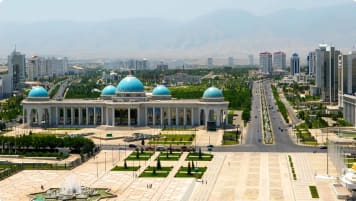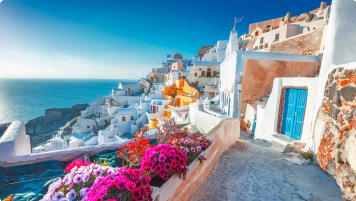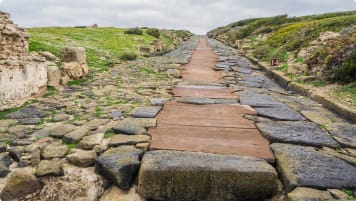Trip to Greece
A Greek Odyssey Greece (Greek: Ελλάς, Hellas) is located in sun drenched Southern Europe, on the southernmost tip of the Balkan peninsula. It boasts extensive coastlines and islands in the Aegean, Ionian, and Mediterranean Seas.…
5 Apr 18 · 21 mins read
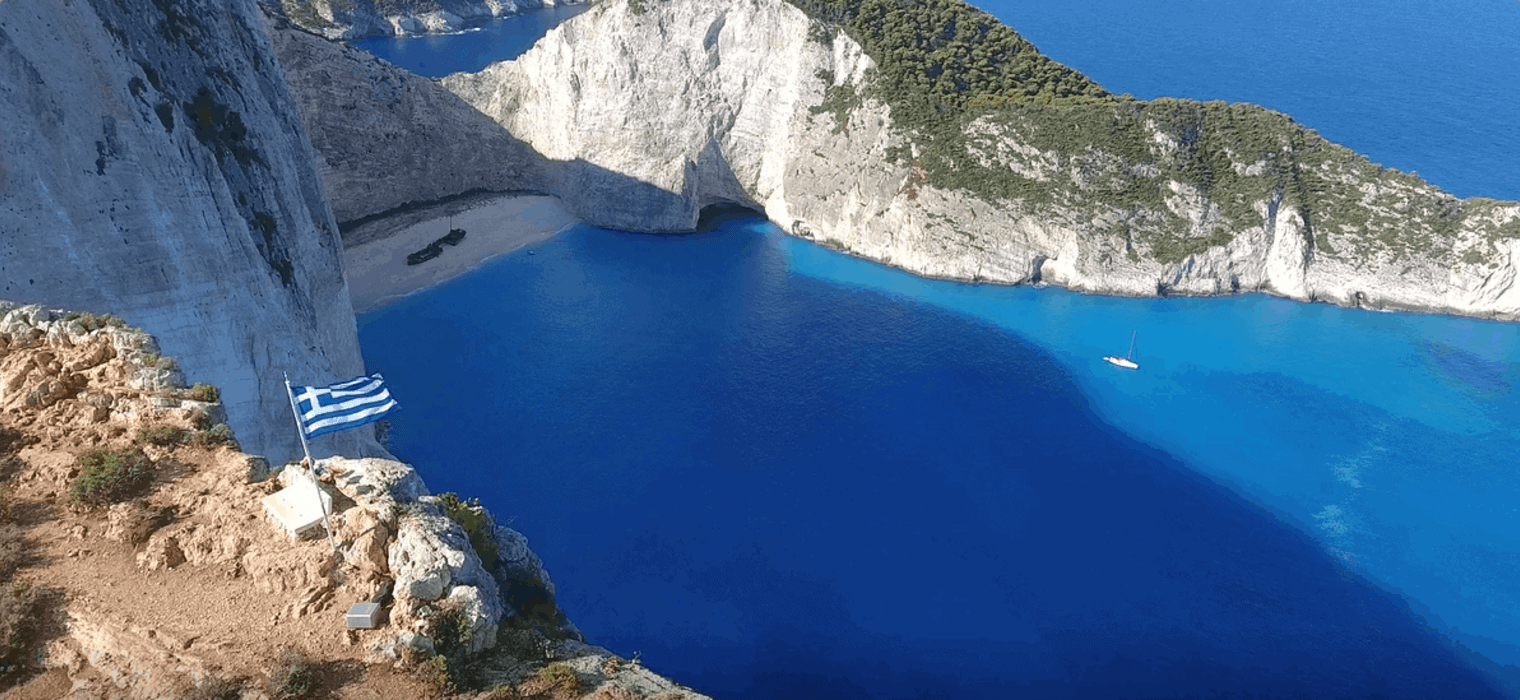
A Greek Odyssey
Greece (Greek: Ελλάς, Hellas) is located in sun drenched Southern Europe, on the southernmost tip of the Balkan peninsula. It boasts extensive coastlines and islands in the Aegean, Ionian, and Mediterranean Seas. Greece shares borders in the north with Albania, North Macedonia, Bulgaria, and Turkey. It has a proud, ancient culture that has had a significant influence on the arts including the genres of comedy and drama, language, philosophy, politics, sports of western society, western alphabets, Platonic ideals and the Socratic method, democracies and republics, and the Olympics. On top of all this, it’s a geographically appealing place to visit, with a mountainous mainland and idyllic island beaches. If the following article captures your imagination, you might like to check out our small group tour to Greece for senior travellers.
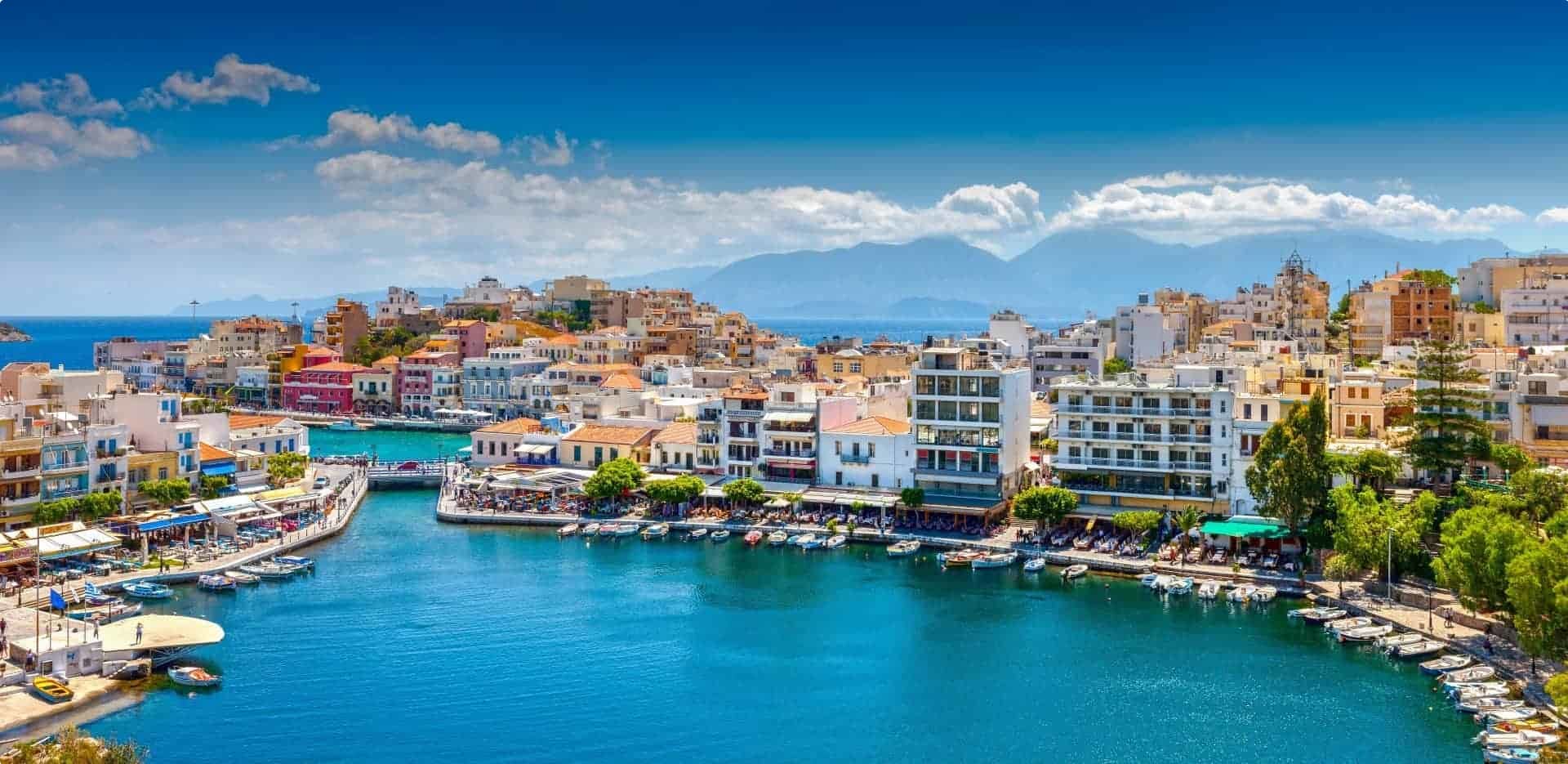
Travel in Greece
Over 90% of visitors who come to Greece come from other European countries, although in recent years there have been growing numbers of tourists from other world regions. The vast majority of visitors arrive during the tourist season, which is April through October. Peak season is July through August. Most of the tourists and tourism industry are concentrated in Crete, the Dodecanese, Cyclades, and Western Greek Islands, and to a lesser extent the Peloponnese and the Halkidiki peninsula in Macedonia. There are still many rewarding areas in the country free of large-scale tourism. For tips on how to avoid crowds when you travel, click here. You may also like to read our article on responsible tourism, which includes suggestions like off-peak and shoulder-season travel.
A land of surprises
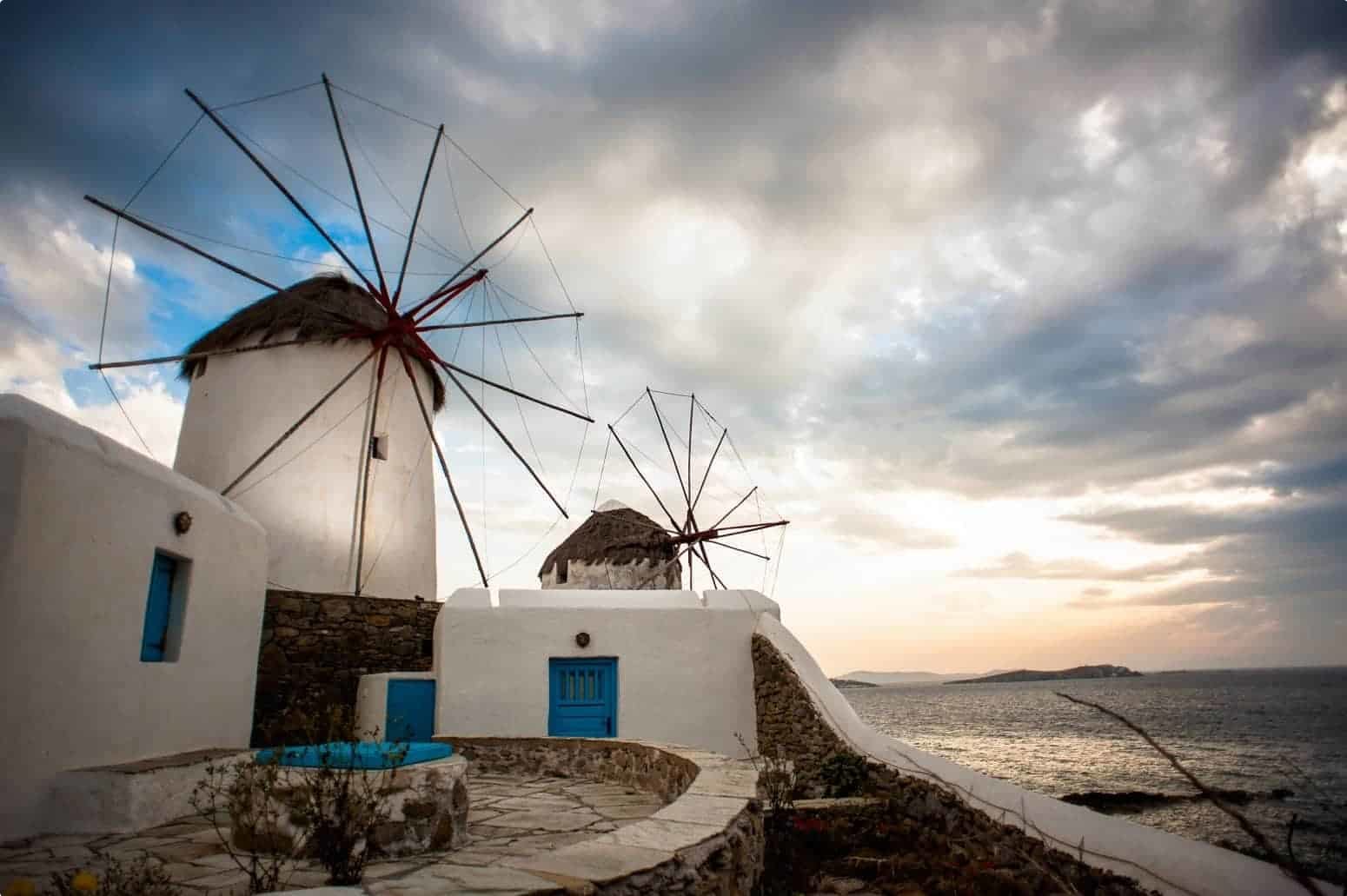
Many first-time visitors arrive in Greece with specific images in mind and are surprised to discover a country with such regional and architectural diversity. The famous whitewashed homes and charming blue-domed churches only characterize a specific region of the country (the Cyclades Islands). Architecture varies greatly from one region to the next depending on the local history. Visitors will find Neoclassical architecture in the cities of Ermoupolis and Nafplion, Ottoman-influenced buildings in Grevená and Kozáni, whitewashed Cycladic homes on the island of Paros, and pastel-colored baroque homes and churches on Corfu.
The nation’s terrain is just as varied as its architectural heritage: idyllic beaches, towering mountain ranges, wine-producing valleys, vast stretches of olive orchards in the south and lush forests in the north. Greece’s historical sights are diverse; the country is dotted with just as many medieval churches and castles as classical ruins and temples.
Highlights of Greece
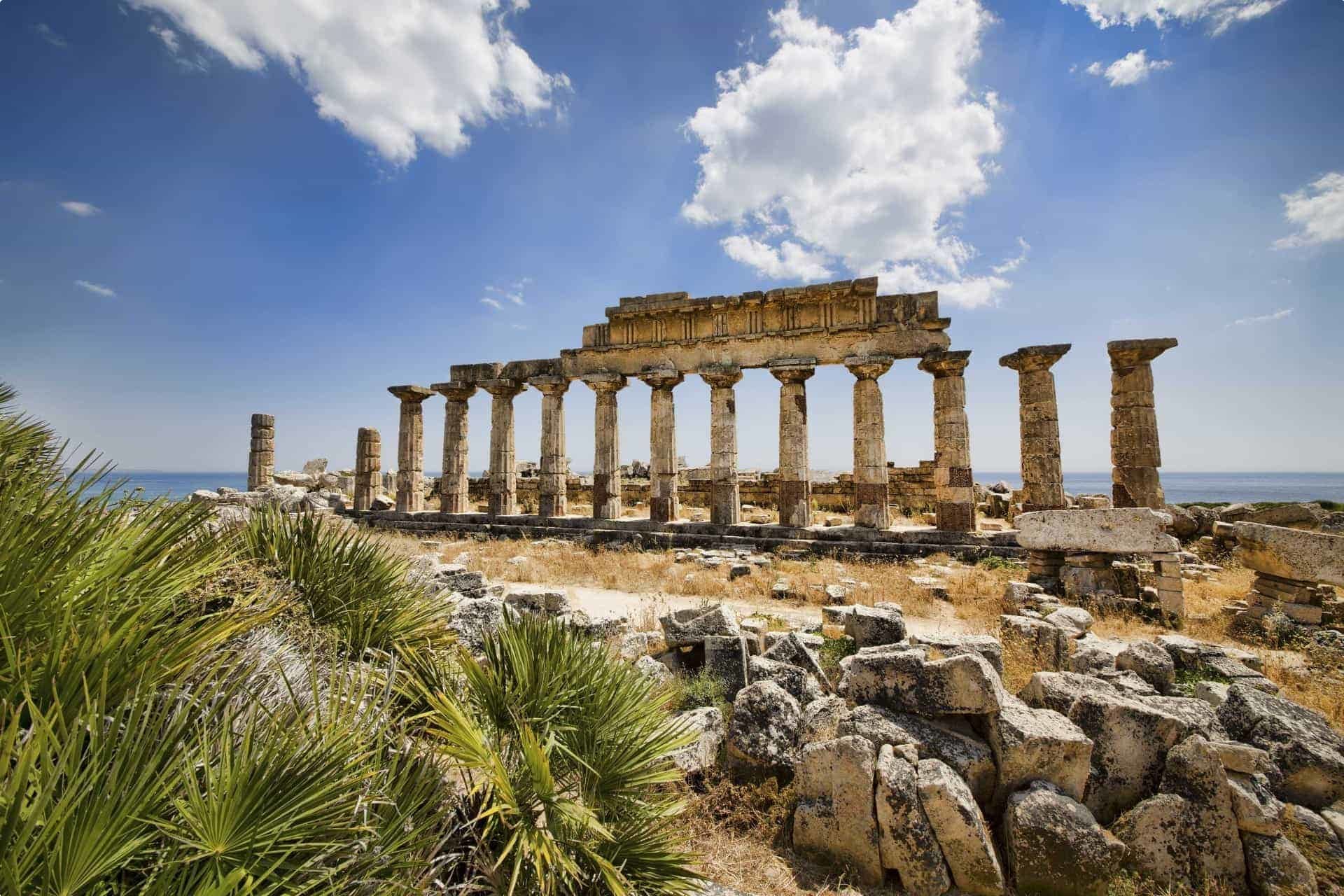
Greece prides itself on a heritage that is one of the cornerstones of Western civilization. A long list of first class historic landmarks remind one of the days when the great Greek emperors and writers made their mark on the development of science, literature and democracy. No less than 17 of those monuments are listed as World Heritage Sites.
However, the many charming little islands, sandy beaches and picturesque whitewashed coastal towns are at least as much a reason to come for the millions of tourists that this Mediterranean country receives each year. Some of Greece’s top destinations:
- The Acropolis: the most famous monument from the ancient world – the Acropolis embodies classic Athens, crowned by marble temples sacred to the city’s goddess Athena.
- Plakias: discover hidden beaches and hill walks in olive groves
- Kos: you’ll find long, powder-soft beaches between verdant landscapes and blue waters
- Santorini (Thira): a postcard-perfect destination that provides a glimpse of the sophisticated Greek lifestyle
- Corfu: garden isle of Greece, with centuries-old historic influences merging with a modern-day holiday paradise
- Hydra: one of the most beautiful island towns in Europe inhabited by generations of famous seafarers
- Plaka, Monastiraki and Thissio: these charming historic districts are at the foot of the Acropolis. There’s restored 19th century neoclassical homes, pedestrianized streets, shops and restaurants, set amongst picturesque ruins from the city’s Roman era.
- Patmos: it is here that St John is said to have written the Book of Revelations
- Panathinaiko Stadium: the stadium that housed the first modern day Olympic Games of 1896. It is an enormous, white, marble stadium, with a horseshoe configuration.
- Thessaloniki: the second largest city in the country with a continuous 3,000-year history, preserving relics of its Roman, Byzantine and Ottoman past and of its formerly dominant Jewish population. Its Byzantine churches, in particular, are included in UNESCO’s World Heritage list.
- Meteora: the hilltop monasteries here are some of Greece’s most stunning and spiritual sites
- The Mani: Peloponnese’s secret treasure, deep with Maniot history and extraordinary architecture
- Chalkidiki: one of the country’s most popular tourist regions with excellent beaches, numerous ancient sites and charming villages. It’s also home to superb wineries, secluded beaches and the monastic community of Mt Athos
In the following sections, we will go through some of the best cities and regions in Greece in a little more detail. A brief history of Greece is outlined, as well as some facts and travel tips. Read on if you are interested in visiting Greece as a mature or senior traveller.
Athens
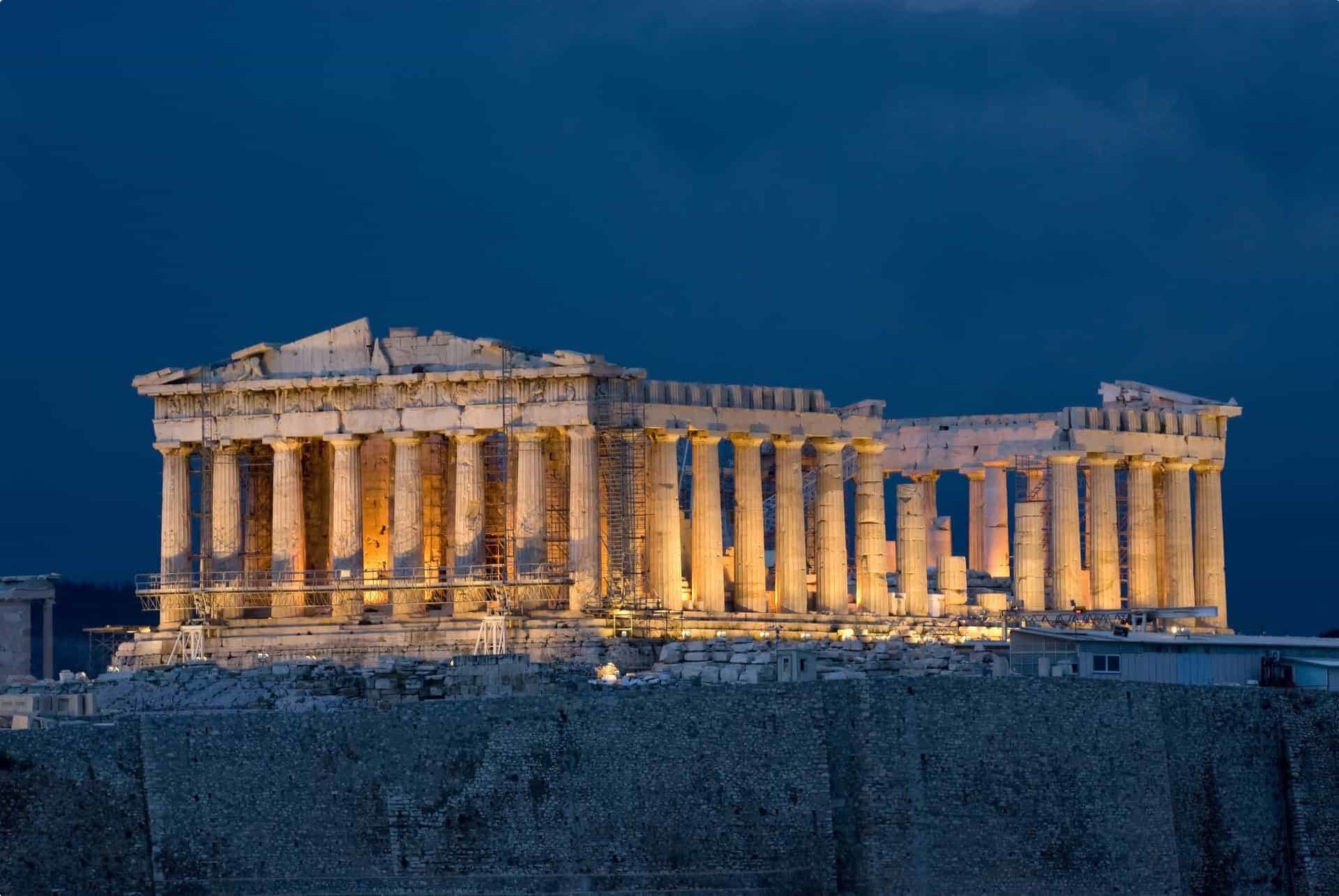
Athens is a large, sprawling city still dominated by breathtaking landmarks from the 5th century BC, such as the Acropolis, Plaka and Agora. Classical Athens was a powerful city-state and centre for arts and philosophy. Modern-day Athens is a cosmopolitan metropolis. If you can overcome the traffic congestion and chaos of this busy city, you will find an emblem of the clashing of eras. Enjoy the fascinating mix of neoclassical, Byzantine, Ottoman, ancient and modern architecture as you make your way through Athens. Furthermore, the Acropolis Museum offers great opportunities to deepen your knowledge of history. The Museum houses archaeological finds from the slopes of the Acropolis, and much more.
The Peloponnese

From Athens, move west to cross the narrow Gulf of Corinth and you will reach the Peloponnese Peninsula, a region in south Greece. Originally a peninsula connected to the rest of the country by the Isthmus of Corinth, it is now cut off from the mainland by the narrow Corinth Canal, spanned by bridges connecting Peloponnese to Attica.
The Peloponnese has played a major role in Greek classical and modern history. It’s here that Hercules fought the lion, and the region’s rugged topography is primed for defending against ancient battles. The snow-capped mountains and deep gorges once kept enemies at bay; now tourists come from all over, drawn to the crystal waters of the Peloponnese. They are welcomed by the famous Peloponnese hospitality, and a regional cuisine that will linger in your memory long after the holiday is over.
Kalamáta
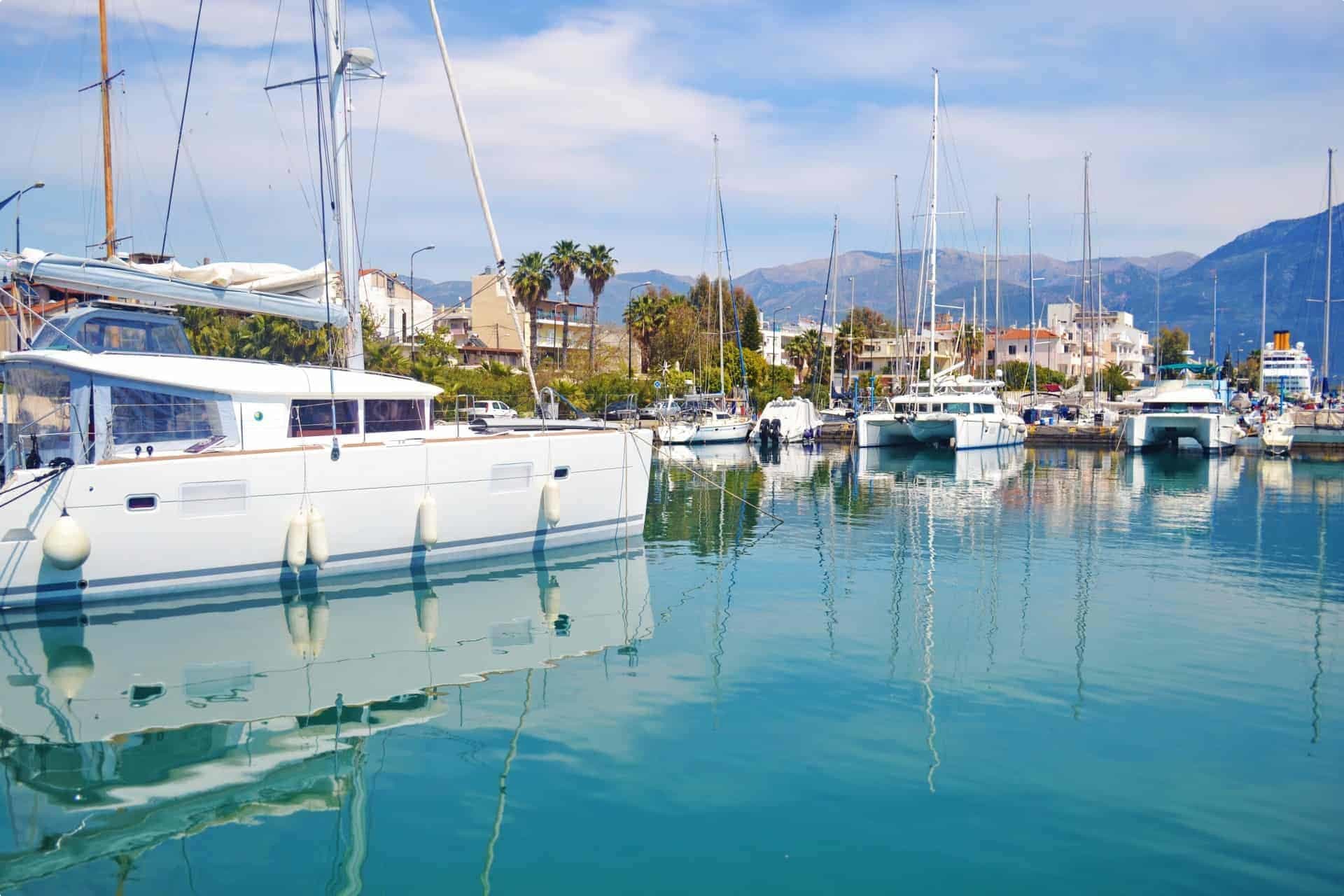
Kalamata, Greece.
Kalamáta is the major town of the Southern Peloponnese, and the capital of Messenia. In 1986, the city was destroyed by an earthquake that damaged over 10,000 homes. Thankfully, the city was rebuilt, and is now a beautiful place to visit. Most famous for its olives, it also home to an attractive seafront and stylish marina. Furthermore, Kalamata is the perfect base from which to explore the Southern Peloponnese and the Mani Peninsula.
From Kalamata, you can experience the Mystra (Mystrás), once a great Byzantine city of more than 20,000 inhabitants which controlled a large medieval region. And Pylos, with its great medieval castle and fine natural harbour, scene of the naval Battle of Navarino during the Greek War of Independence in 1827. There’s Nestor’s Palace, the best-preserved of all Mycenaean palaces. And the remarkable Diros Caves, inhabited originally in Neolithic times and rediscovered in 1895. Of course, you might also like to visit the ancient battleground of Sparta, where you will learn that these brave people lived without fortifications, triumphantly defending the land until the fateful Battle of Leuctra in 371BC.
Olympia
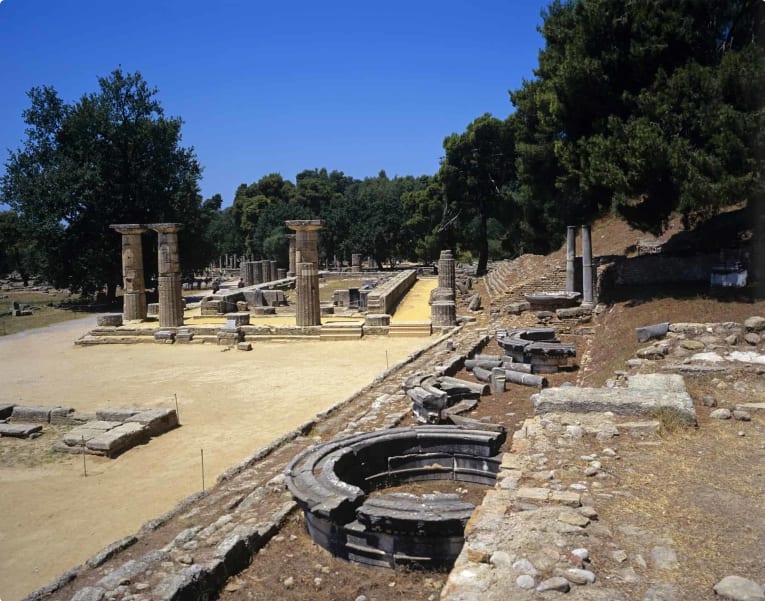
The archaeological site of Olympia is the site of the first Olympic Games, originally between competing Greek city states. The first Olympiad is thought to have taken place in 776 BC. The classical period, between the 5th and 4th centuries BC, was the golden age of the site at Olympia. A wide range of new religious and secular buildings and structures were constructed. During the Roman period, the games were opened up to all citizens of the Roman empire. But the 3rd century saw a major earthquake that damaged the site. Rival tribes invaded and robbed some of the monuments, but still the Games continued until Christian emperor Theodosius implemented a ban in 393 AD. Theodosius II furthered the decline, enforcing a ban on pagan festivals. Key buildings were destroyed or inhabited by Christian communities. It is believed a version of the Games continued in secret until the mid 6th century, when two earthquakes and the Plague of Justinian devastated the region. Repeated floods ensured that the settlement was finally abandoned altogether in the early 7th Century.
As time went on, the site became buried in alluvial deposits that were up to 8 metres deep. Initially, these deposits were attributed to river flooding, but modern research indicates another hypothesis. The presence of mollusc and gastropod shells, and foraminifera (shell-covered amoeboid organisms) suggests the site was buried with ocean water resulting from repeated tsunamis.
The exact site was re-discovered in 1766 by the English antiquarian Richard Chandler. The first excavation of the sanctuary at Olympia was not carried out until 1829, by the French “Expedition Scientifique de Moree”. Its extensive ruins include athletic training areas, a stadium and temples dedicated to the gods Hera and Zeus. The Archaeological Museum of Olympia exhibits finds from the site, including a statue of Hermes attributed to the sculptor Praxiteles.
Corfu
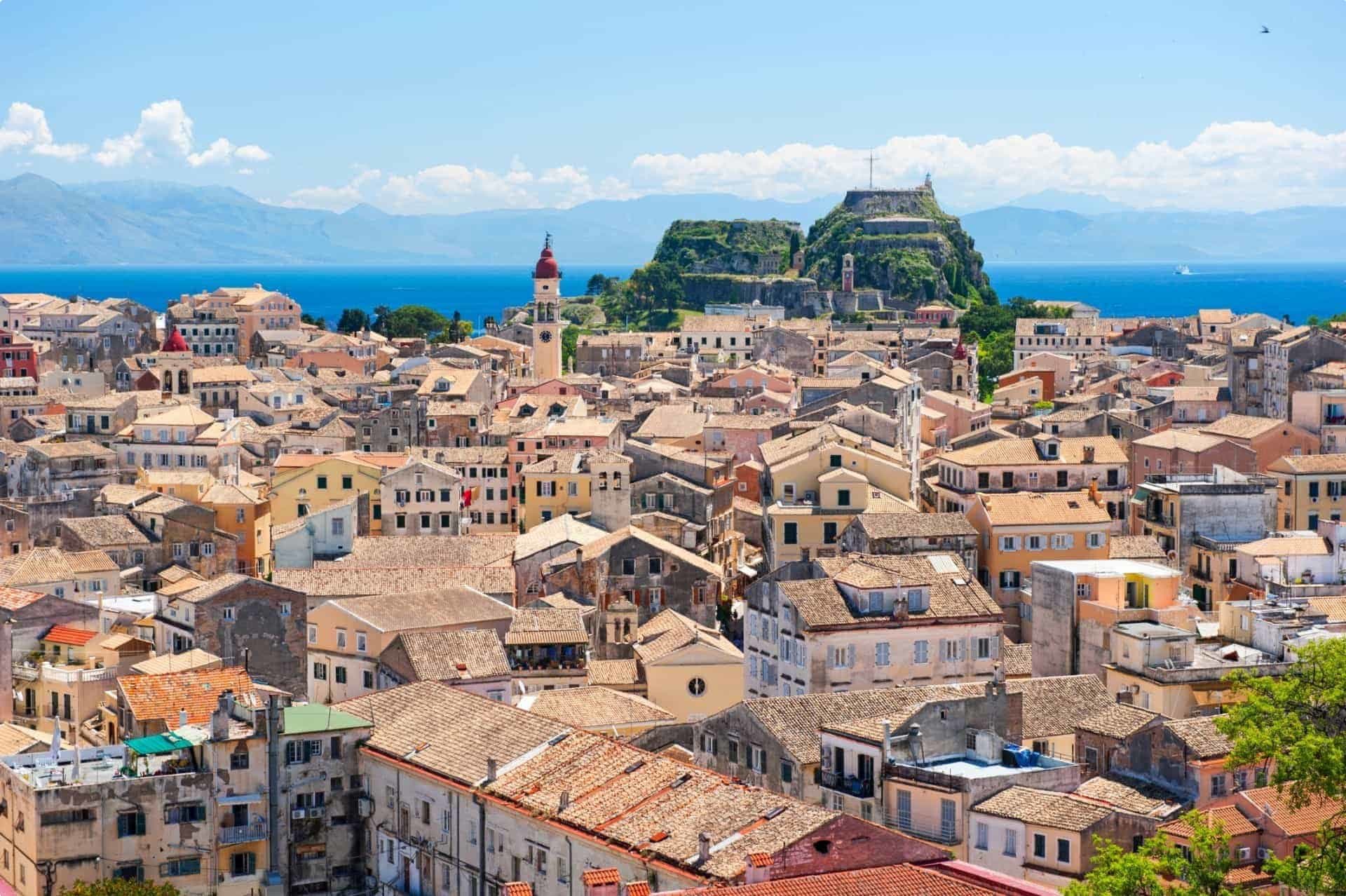
The island of Corfu, located in the Ionian Sea between Italy and the west coast of Greece, is renowned as a major European tourist island destination. Its history and culture reflect its occupation by western European powers including the Venetians, French and British, at various times since the 14th century. Kérkyra Town is the main settlement on the island. Its old buildings suffered massive damage from German air-raids during the Second World War but were renovated for an EU Summit Meeting in 1994.
In Corfu, you can visit major historical sites in Kérkyra Town, with its massive forts. On the far north-west coast of Corfu is Paleokastrítsa. This small village has a dramatic setting of hills and sea and is identified by Homer as Scheria in ancient mythology.
The Meteora
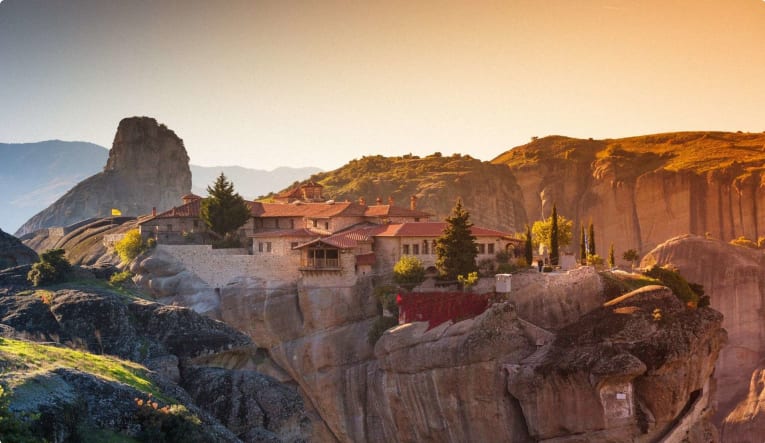
The monasteries perched on top of rock pinnacles near Kalambaka are arguably the most spectacular visitor site in Greece. Meteora means “rocks in the air”, and the remaining six monasteries are built on the top of isolated hard-sedimentary strata which have resisted erosion over the centuries. The earliest religious communities are believed to have occupied nearby caves during the 10th century AD. Monastic communities developed during the 14th century. At their peak during the 16th century, it is believed that 24 of the pinnacles were occupied by monasteries or hermitages. Today only two of the monasteries continue to function as religious communities, while six are open to visitors as museums.
Delphi
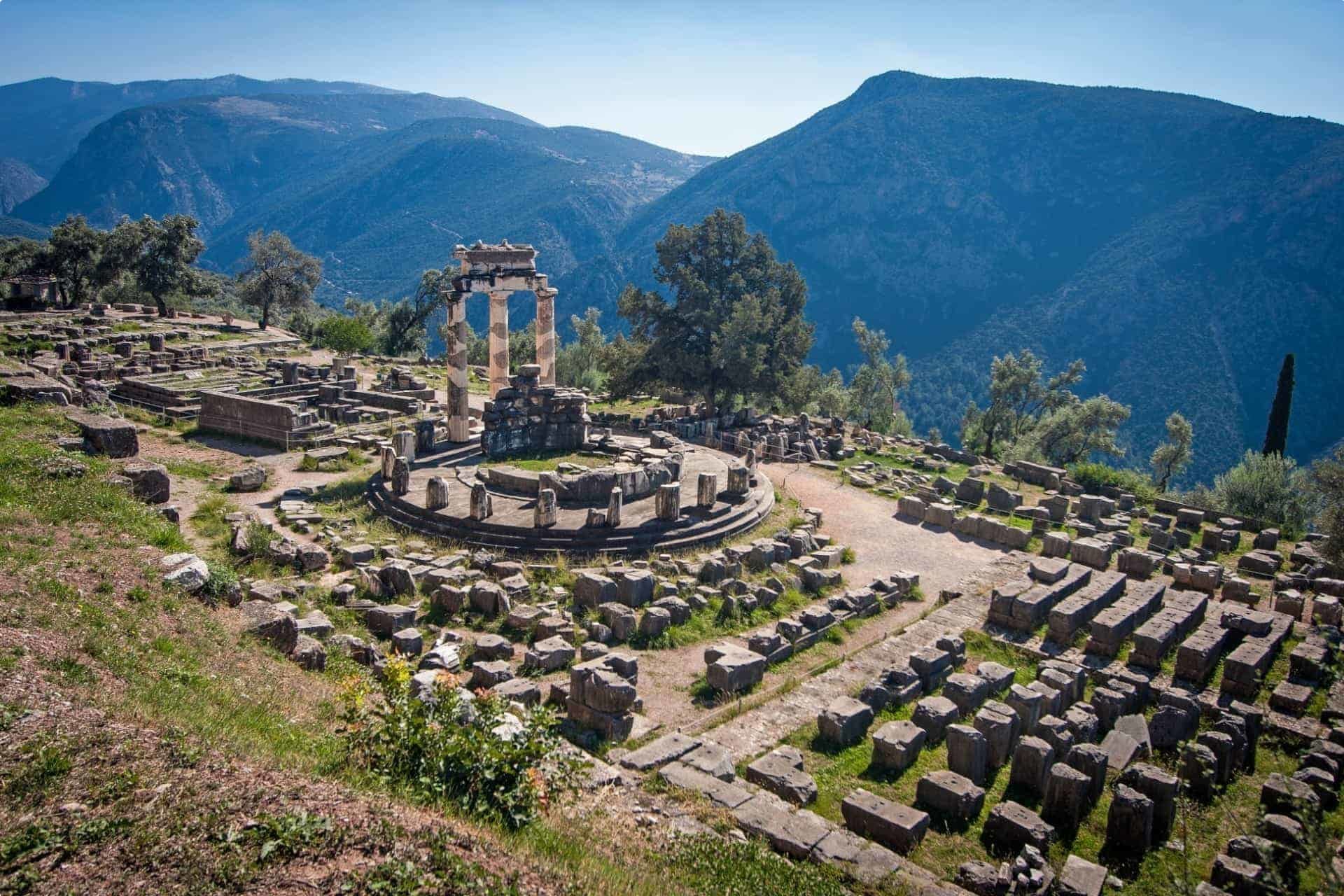
Believed by the Ancient Greeks to be the centre of the earth, Delphi is set on a large terrace on the slopes of Mount Parnassos. Delphi was one of the most important centres of Ancient Greece and it was here, at the Sanctuary of Apollo, that the priests and others consulted the Oracle to know their fortunes. Delphi was known to exist in the 12th century BC and reached its zenith during the 6th century BC. It declined from the 4th century BC and was abandoned during the Roman era by Emperor Theodosius, who deemed Delphi to be a pagan sanctuary.
A visit to the archaeological site of Delphi including the Sacred Precinct, the Castalian Spring and Marmaria, together with the stadium and the museum, will shed light on this fascinating piece of history.
Mykonos
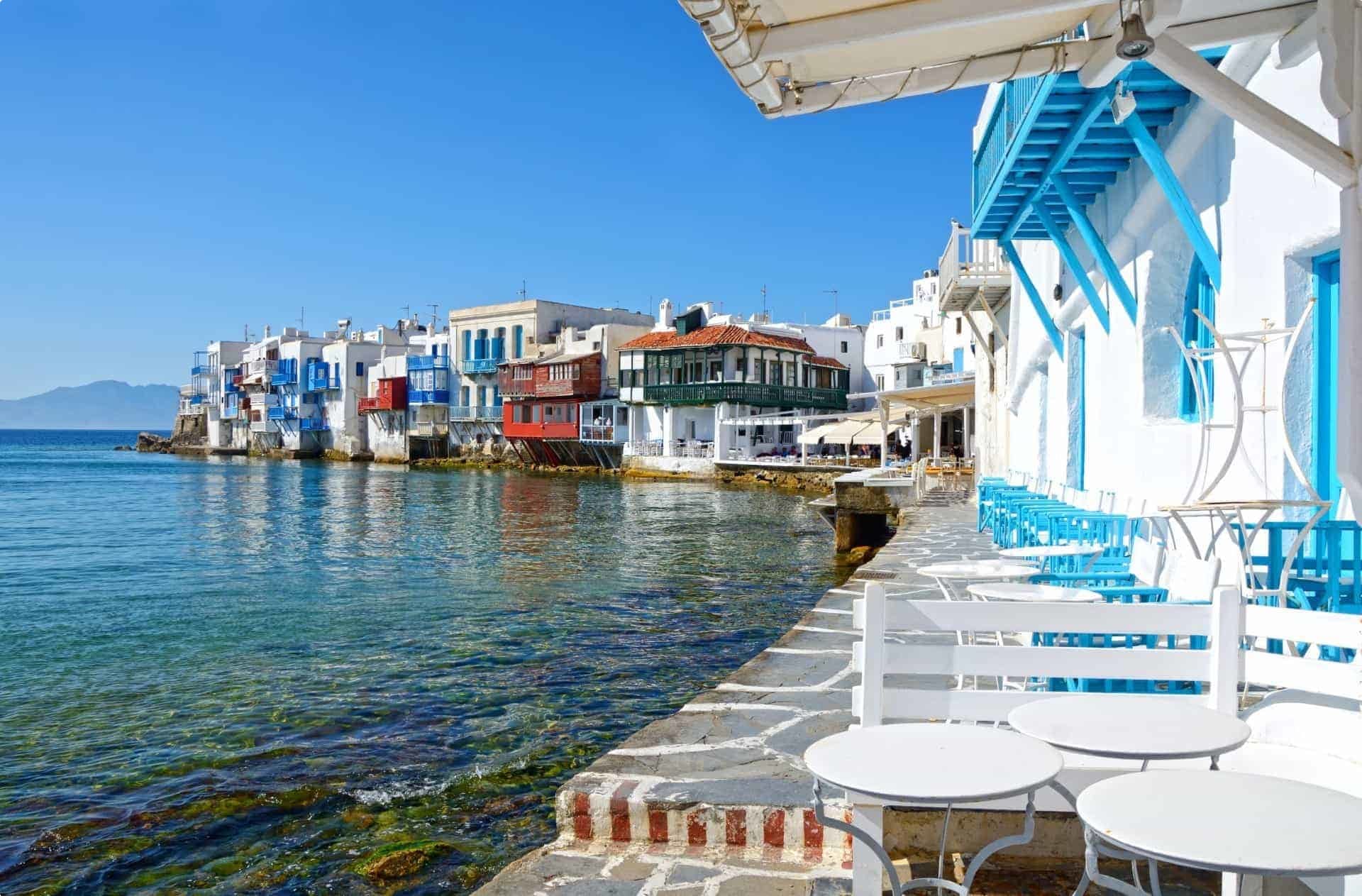
Glitzy, glamorous Mykonos is a beloved destination for party-going tourists. Its bars, restaurants and cerulean waters promise fun for the frivolous, but time your travel right, and you might experience a whole other Mykonos. Its whitewashed buildings include the Folk Museum, where you can view a wide collection of ceramics, embroidery and Mykonian textiles. The picturesque Little Venice precinct is a photographer’s dream. The buildings overhang the water, here, and the famous windmills serve as a backdrop. A maze of dazzling white alleys and fishermen’s dwellings also round out Mykonos. The convoluted streets were intended to confuse pirates and invaders and still succeed in confusing visitors today! Be sure to check out the Paraportiani: the asymmetrical group of four chapels which makes up the oldest church in Mykonos.
Delos
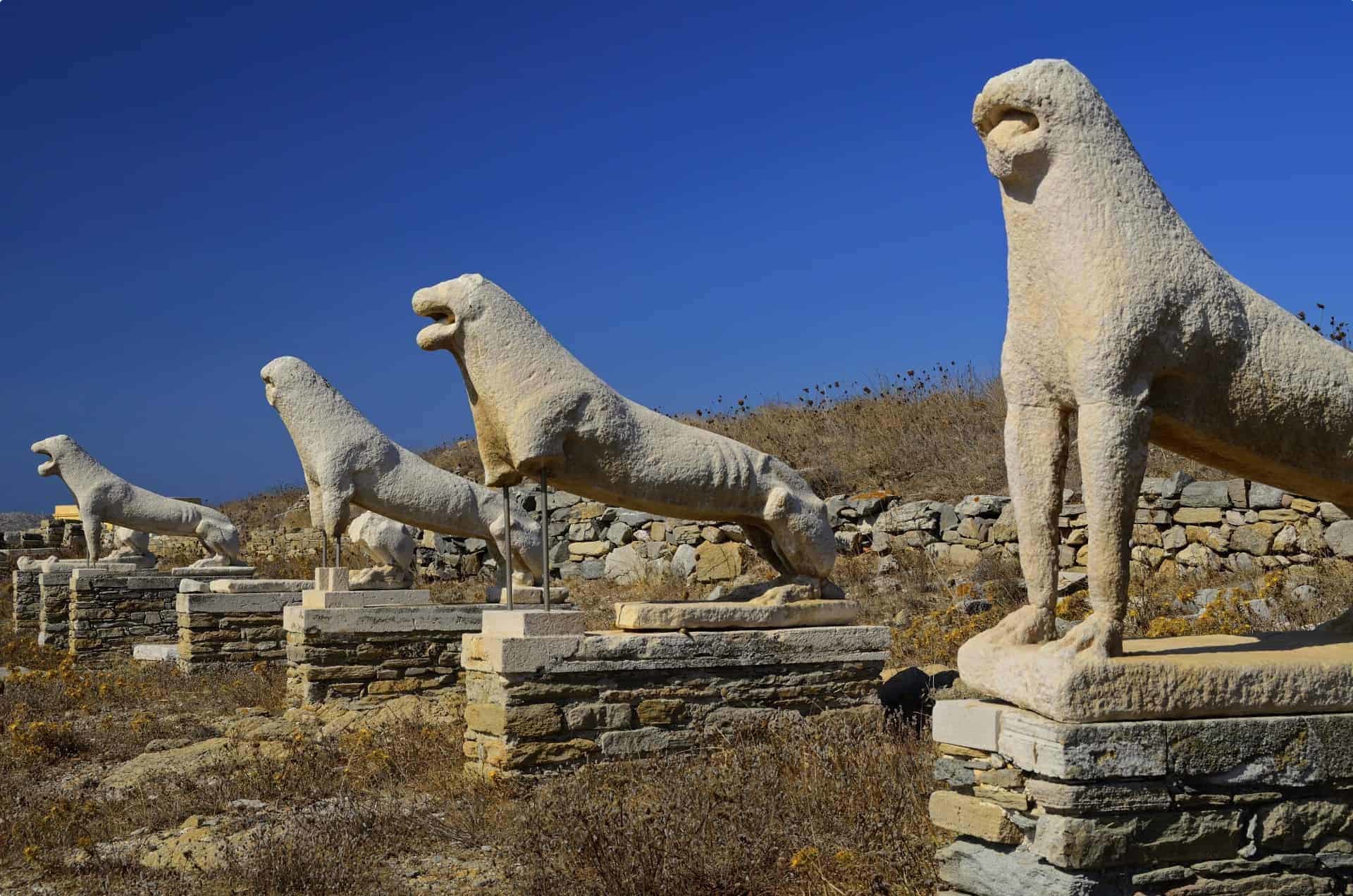
First inhabited in the 3rd millennium BC, Delos is one of the most important archaeological sites in Greece. It is the mythical birthplace of Apollo and Artemis. The island can be reached by a short boat ride from Mykonos. It sits near the centre of the Cyclades archipelago. A 2001 census reported a population of 14 people. The island is mostly given up to archaeological excavations: the most extensive in all of the Mediterranean. Its landmarks include the Doric Temple of Isis and the Delos synagogue: the oldest synagogue known today. A line of up to 15 stone lions was erected at Delos around 600BC. The Terrace of the Lions is an iconic image of the site, and though the original statues were moved to a museum for conservation, their replicas give a sense of what once was.
Pearls of the Aegean
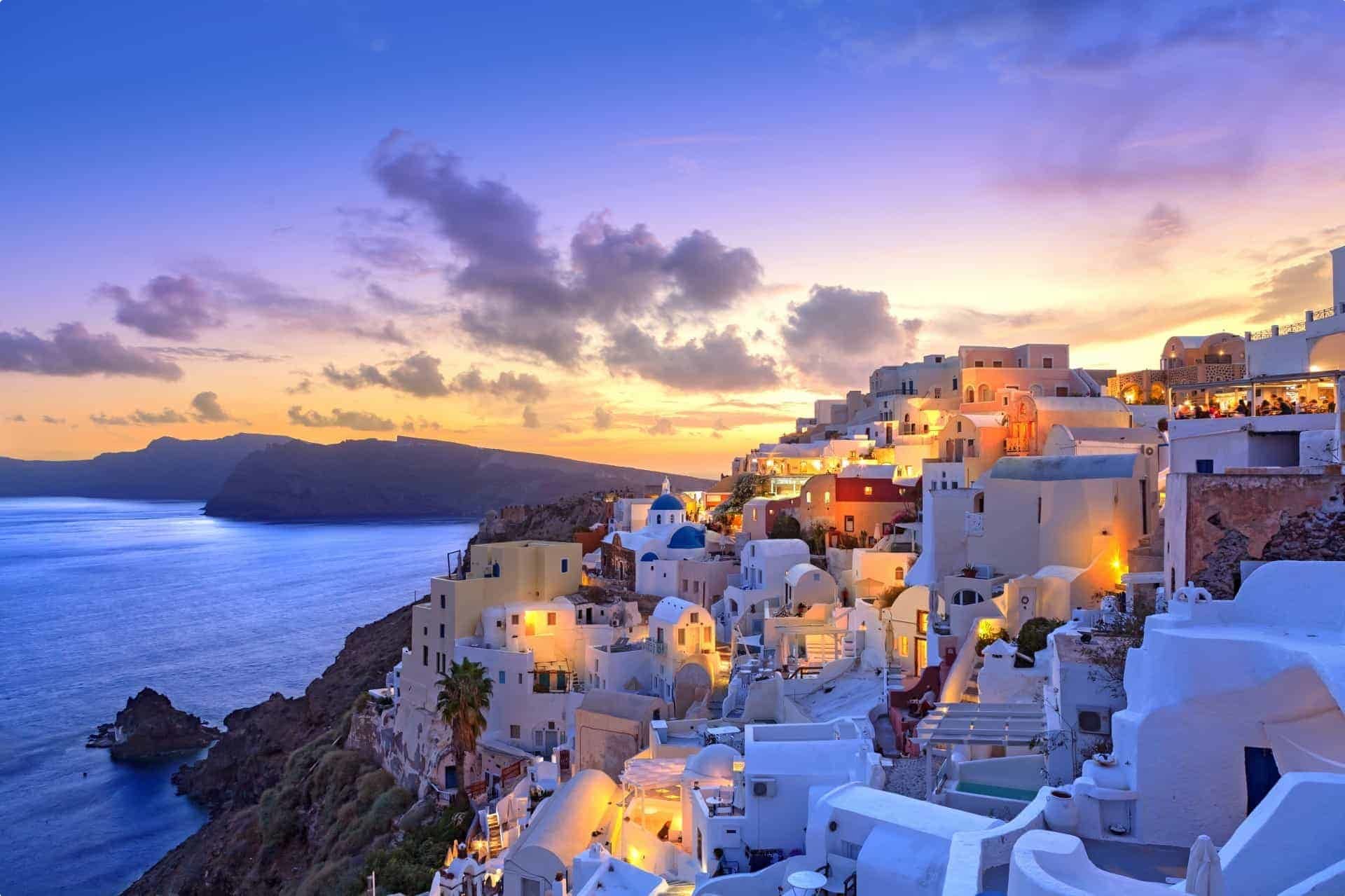
The Aegean Sea is an elongated embayment of the Mediterranean Sea. It separates Greece to the west from Turkey to the east. The region has been a maritime crossroads for thousands of years. It has seen a succession of civilisations including the Ancient Greeks, Byzantines, Venetians and the Turks. Hellenic influence and Greek culture prevail today, and the islands are now a holiday paradise for Greeks and foreigners alike. A cruise is the perfect way to experience the wonders of the Aegean Sea. They include:
- A visit to Kusadasi in Turkey to view the great ruins of Ephesus.
- Patmos, often referred to as the Jerusalem of the Aegean, where St John wrote his Revelations.
- Rhodes (Rhodos), the largest island of the Dodecanese, exploring the medieval city, the legacy of the crusading Knights of St John, the Street of the Knights and the Palace of the Grand Masters. The Knights were later forced to retreat to Malta by the Ottoman Turks in 1522 – 1523. In 1922 the island was seized by the Italians from the Turks and later returned to Greek rule. We will also visit the ancient acropolis and citadel at Lindos.
- Crete (Kriti), to visit Iráklion and explore the Palace of Knosos, built around 1700 BC and uncovered in 1900 by the famed archaeologist, Sir Arthur Evans. Here, Theseus confronted the Minotaur. Of further interest is the fact that Australian and New Zealand troops confronted German paratroops on Crete in 1941. 2011 was the 70th anniversary of the Battle of Malacene. New Zealanders and Australians who were involved in the battle attended the commemorations in May, along with local official government representatives from down under.
- A visit to Santorini (Thira), a volcanic breached caldera, with its white villages clinging to the spectacular volcanic cliffs. Santorini is infamous for being the site of a number of major earthquakes over the years. If possible, time your visit to coincide with a dramatic sunset in the village of Oia.
For more inspiration on travel in Greece, check out the country’s official tourism website here.
A Brief Overview of Greek History
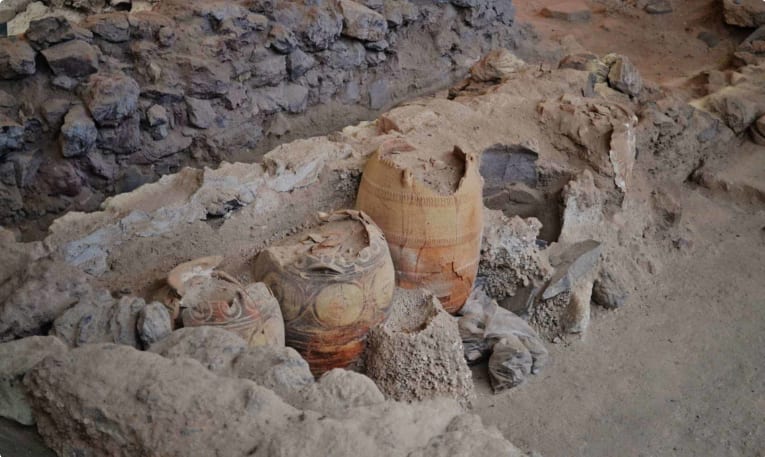
The Neolithic, Minoan & Mycenaean Eras
The earliest archaeological evidence of human occupation in Greece dates from around 7000 BC. These were the first pre-Hellenic settlers probably migrating from Anatolia in what is now central Turkey.
Between approximately 2000 BC and 1100 BC the Minoan and Mycenaean civilisations dominated through control of sea trade. Great royal palaces were built during this era. Most of the Greek myths and legends originate at this time and were recorded by Homer and his disciples. Many groups vied for control of agricultural land and trade, and wars were frequent.
The Dorian & Classical Eras
The Dorian and Classical eras followed after about the 11th century BC. This is when the first Greek alphabet appeared. The 9th century BC saw the emergence of the famous Greek city states of Sparta and Athens. Power struggles between Athens and Sparta culminated in the Peloponnesian War of 431 – 404 BC.
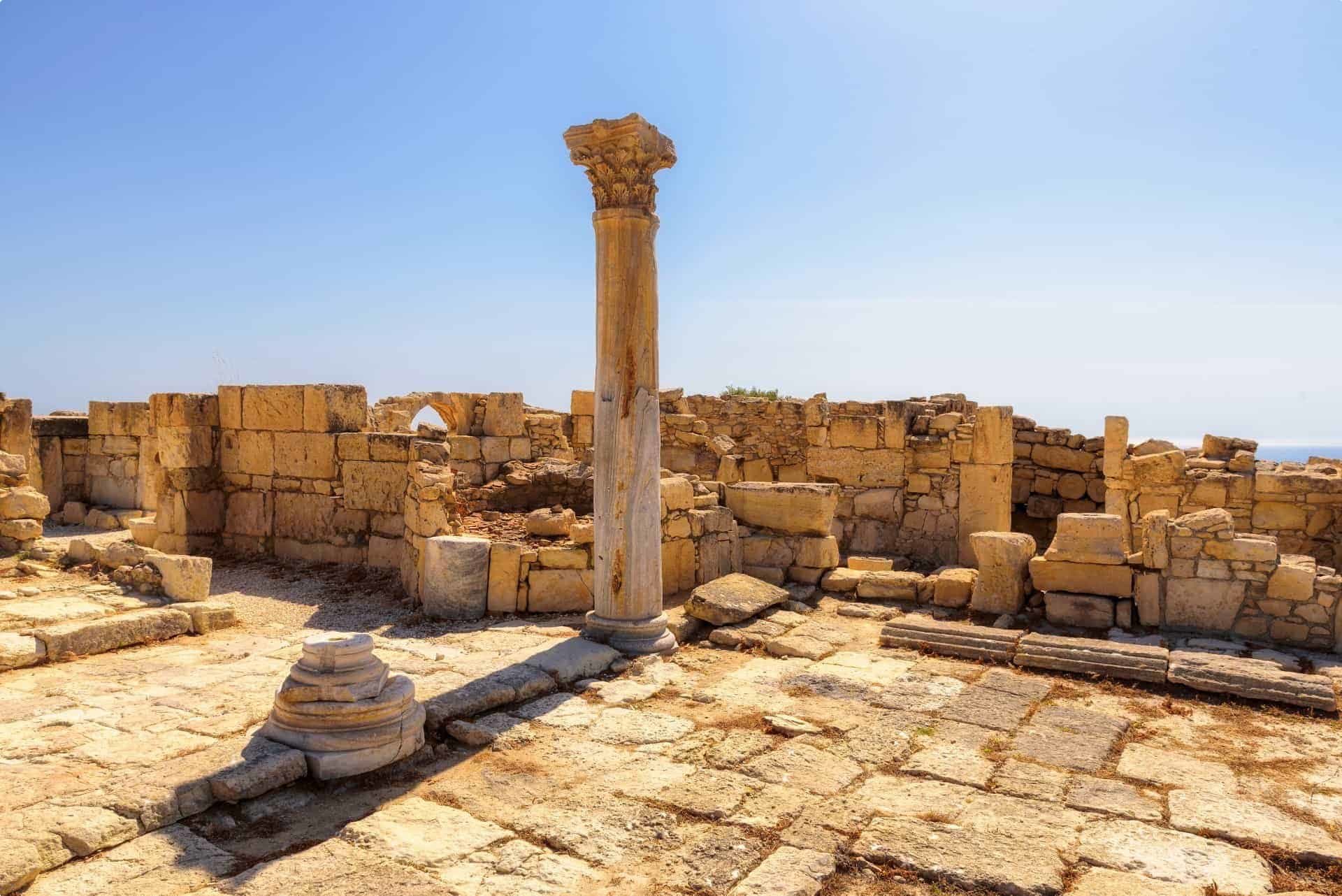
The Hellenistic & Roman Eras
While the city-states were fighting one another, a new great power was emerging outside their sphere to the north. In the kingdom of Macedonia, Phillip II, who reigned from 359 to 336 BC, was developing a strong military force. He conquered Athens and southern Greece. His son, Alexander the Great, in a brief but incredible reign of only 13 years until 323 BC, extended the empire to Egypt, Persia, Afghanistan and India. This unwieldy empire collapsed with Alexander’s death in 323 BC. Hellenistic Greece emerged as one of three Macedonian dynasties.
The Romans conquered mainland Greece over the period from 215 to 146 BC. Rome allowed a high degree of local autonomy in its extensive empire, so Greek language and culture continued to flourish under the Romans. Athens and Corinth remained important centres, while Salonica (Thessaloniki) developed in the north as the Romans built their great network of highways. The Roman Empire began to decline and eventually split into the eastern and western empires.
The Byzantine Empire & Medieval Greece
In 330 AD, Emperor Constantine established the capital of his eastern empire at the Greek city of Byzantium (renamed Constantinople and now modern Istanbul). Christianity was introduced with the conversion of Constantine. By the end of the 4th century AD, it was the official state religion with the liturgies, creeds and the New Testament all written in Greek. The Greek Orthodox religion was established. Over the centuries, Byzantine Greece declined in importance and fielded regular attacks from surrounding groups.
Western European forces made their appearance from the early 11th century. The Crusades were organised to capture Jerusalem and the biblical lands from Islam. Normans landed at Corfu in 1085, just 19 years after invading Britain. The Fourth Crusade of 1204 led by Venetian, Frank and German princes occupied Byzantium and Constantinople. They divided up the empire between themselves.
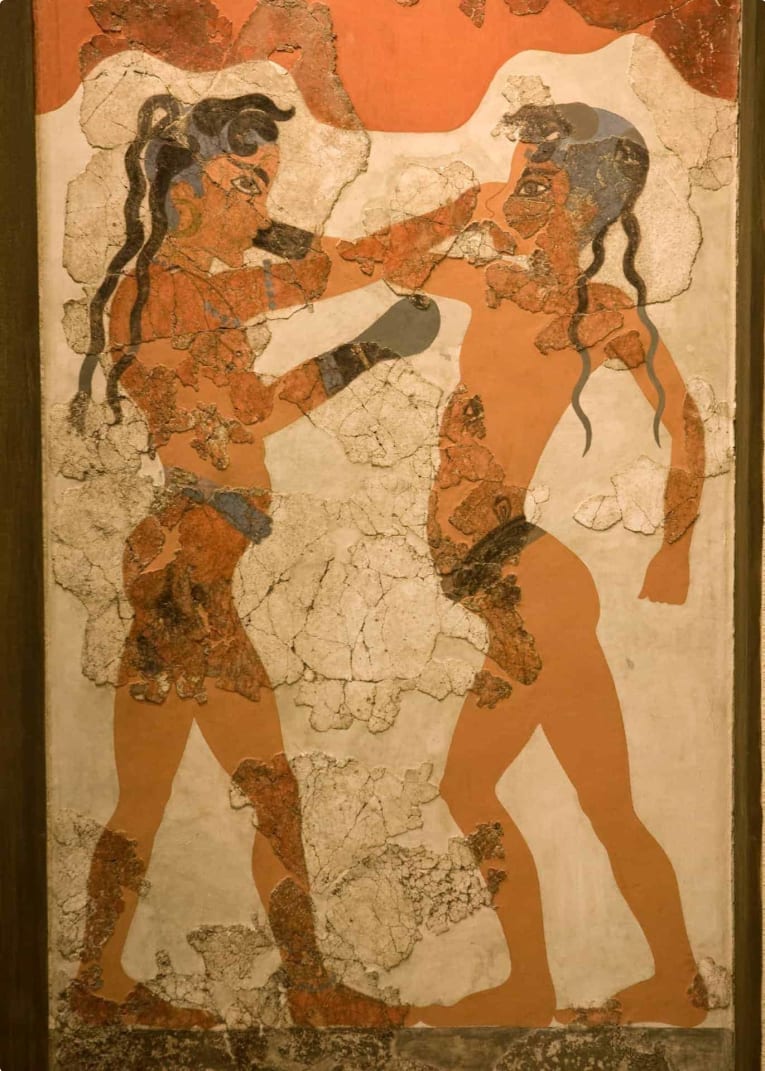
The Ottoman Period
Power struggles among various groups occupied the next two centuries. This continued until the Ottoman Turks, led by Sultan Mehmet II, conquered Constantinople on 29 May 1453. Thus began nearly 400 years of Ottoman rule, which laid the foundations of the present tensions between modern Greece and Turkey. Greece was a colonial outpost of Turkish rule.
During this period, the Greek Orthodox Church was a significant factor in maintaining Greek culture and identity. Greek opposition to Ottoman rule grew and in 1770 a revolt supported by Russia was ruthlessly suppressed. The French Revolution of 1789 inspired more support and in 1821 the rebel Greek flag was openly displayed. The War of Independence began and the local population was supported by European nations and significant individuals such as Lord Byron. The great naval battle of Navarino Bay was fought in 1827 between a combined British, French and Russian fleet against the Turks and the Egyptians. In 1827, Russia declared war on the Ottomans and they were compelled to grant autonomy to Greece. A series of conferences between 1830 and 1832 drew the national borders of modern Greece.
The 19th-Century Post-Independence Era
Modern Greece began as a republic with Ioannis Kapodistrias as the first President. He attempted to establish a strong central government in the face of opposition from powerful local chieftains. He was assassinated in 1831 and the European powers intervened to establish a monarchy, with the German Prince Otto as the first ruler. Otto ruled autocratically until 1862, when he was forced to abdicate by popular revolt. He was replaced by a Danish prince, George, who became George I and was a more capable and popular leader.
19th century Greek foreign policy aimed to liberate Greek-speaking populations from foreign powers and to expand national boundaries. In 1878, Thessaly was ceded to Greece by Turkey. In 1897, Greece was unsuccessful in regaining sovereignty of Crete but eventually achieved this in 1913. A Cretian, Eleftherios Venizelos, was elected as Prime Minister in 1910. In 1912, he led an alliance of Balkan powers which virtually forced Turkey out of Europe in the Balkan Wars of 1912 – 1913. Greece recovered sovereignty of most of the Aegean islands.
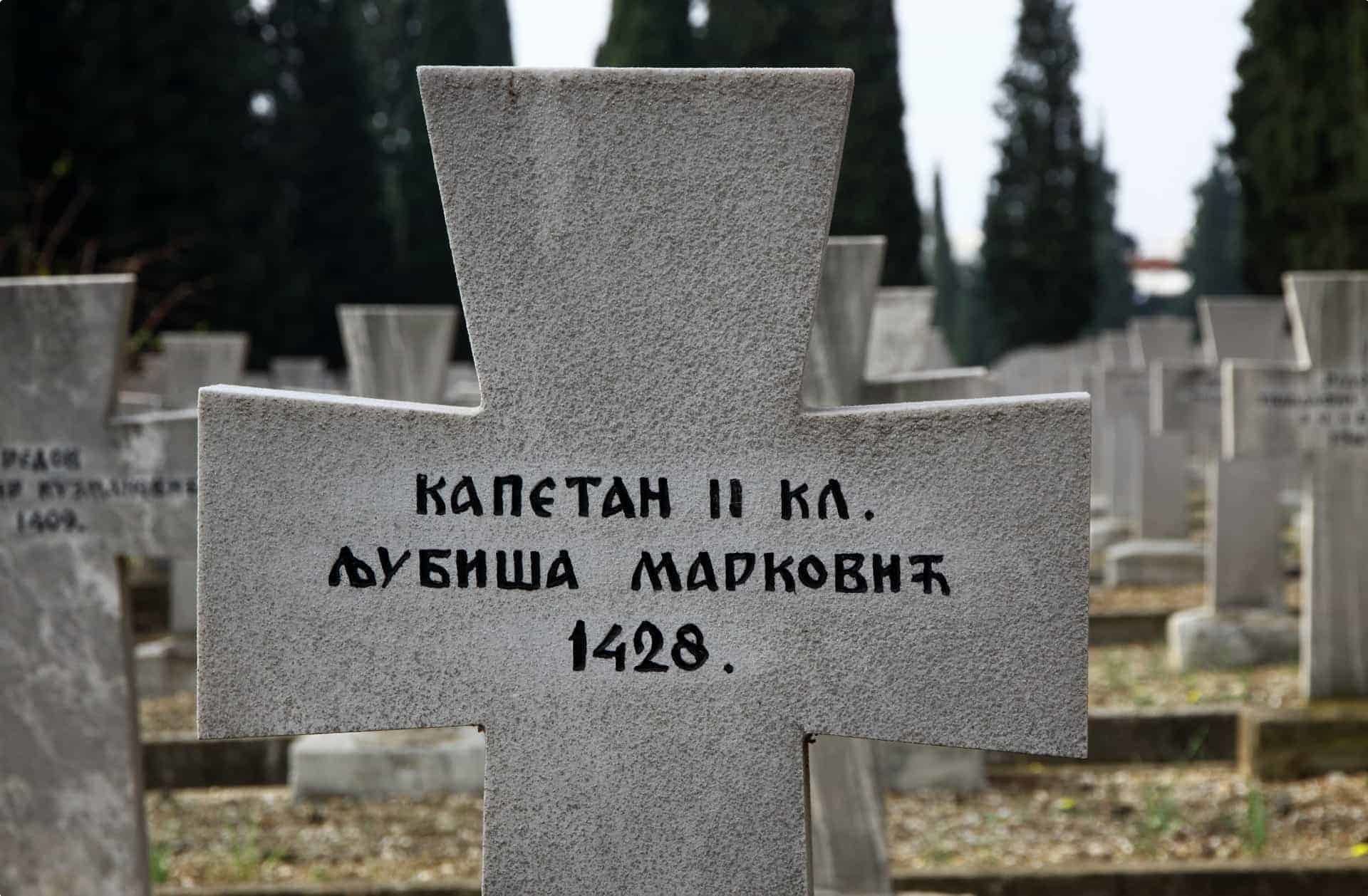
The Post-World War I Period
During World War I, Venizelos endeavoured to have Greece join the Allied forces. However, King Constantine I was married to the Kaiser’s sister and enforced a policy of neutrality. Venizelos set up a revolutionary government in Thessaloniki in 1917 and there was a Civil War. In 1917, Greek troops joined the Allied forces in the Macedonian Campaign. Following the Armistice, Venizelos demanded the ceding of the predominately Greek-speaking Turkish city of Smyrna (Izmir) to Greece. He was refused. Greek troops landed and occupied Smyrna in 1919 and were opposed by forces led by Mustafa Kemal, the Turkish hero of Gallipoli. Venizelos lost the election of 1920 and royalist forces took control. Greek troops were ordered to advance on Ankara but were forced back to the coast in 1922. Turkish troops entered Smyrna and killed most of the Armenian and Greek population before torching the city.
The Treaty of Lausanne in 1923 ordered a massive exchange of minority populations based on religion between Greece and Turkey. More than 390,000 Muslims from Greece, and 1.4 million Orthodox Greeks from Turkey, were forced to re-settle as refugees in a massive exercise of ethnic cleansing. The re-settlement of Greek refugees involved the re-distribution of the last of the great agricultural estates. King Constantine was forced to abdicate by army officers and a republic was proclaimed. The Greek Communist Party was formed during this period. Venizelos was returned to power in 1928 but was ousted in a coup in 1933. The monarchy was restored with King George II in 1935. The King appointed General John Metaxas as Prime Minister and he led a fascist dictatorship.
The Second World War, the Civil War & Beyond
After the outbreak of World War II, Italian Prime Minister Mussolini demanded passage for Italian troops through Greece. He was refused. On 28 October 1940, Greece entered the war and was soon over-run by German, Italian and Bulgarian forces. Australian and New Zealand troops fought and were captured in mainland Greece and Crete in 1941. Nearly half a million Greeks starved to death during the winter of 1941 – 1942 and more than 80,000 Jews were deported by the Nazis.
Political and economic chaos reigned at the end of the war in 1945 and Greece was racked by civil war. The U.S. offered massive economic aid and imposed virtual military rule during a period of reconstruction from 1950 to 1967. During this period, many rural villages were de-populated and tens of thousands of Greeks migrated to Australia, North America and western Europe.
Greece was in political chaos and on 21 April 1967, a coup d’état was staged by a group of military officers. The colonels’ junta took control and banned all political and union activities under a right-wing military dictatorship for the next seven years. In 1974, student revolt and support from overseas Greeks, together with international pressure, forced the junta to quit and Greece returned to civil rule. The ineffectual King Constantine II was rejected and Greece was once again proclaimed a republic.
In 1981, Greece joined the EC (now the EU); it became the 12th member of the European Economic and Monetary Union in 2001.
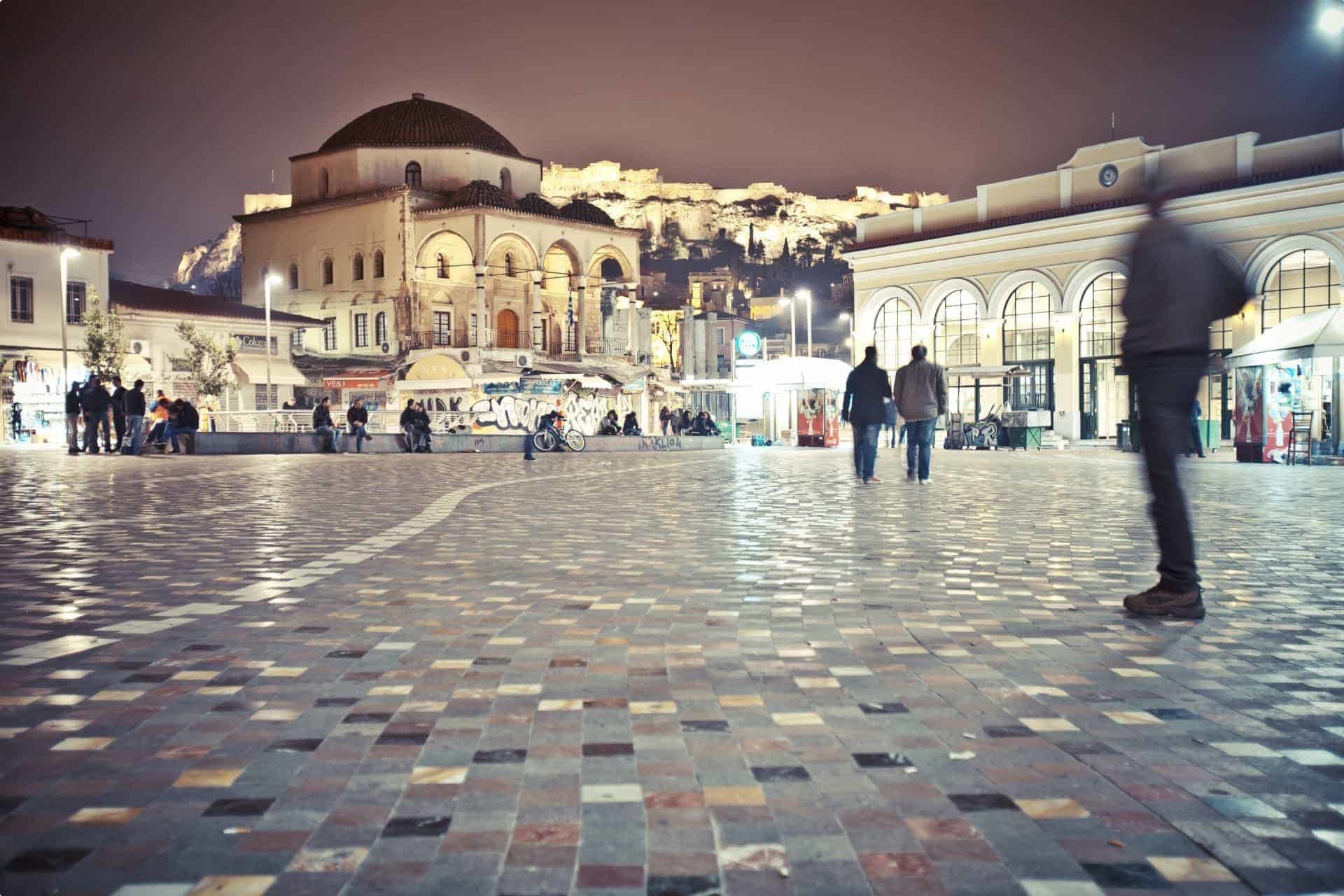
Greece in the Twenty-first Century
In March 2004, Costas Karmanlis’ new Democratic Party defeated Papandreou’s Pan Hellenic Socialist Movement (PASOK), which had governed for all but three years since 1981. Athens hosted the Olympic Games in 2004.
In 2010, the prospect of a Greek default on its euro-denominated debt created severe strains within the EMU. The question was raised as to whether a member country might voluntarily leave the common currency, or be removed. While bail-outs staved that off, Greece’s economic problems escalated. 2012 saw greater economic disruption in Greece, with many Government employees being made redundant and unemployment spiralling within the population. Greece was virtually bankrupt.
After several European bail-out packages, all subject to strict conditions and accompanied by severe austerity measures, Greece achieved a primary government budget surplus in 2013. In April, 2014, Greece returned to the global bond market, and in 2014 returned to national growth, after six years of economic decline. In mid-2015, Prime Minister Alexis Tsipras agreed to the terms imposed by Eurozone leaders attached to an 86-billion-euro bail-out. Greece will now be held to a tight repayments schedule, with the government all but forced to carry out a suite of widely unpopular austerity programs, including sweeping budget cuts to public services and drastic changes to bankruptcy laws. Greece’s complex and dramatic history only adds to its fascinating stories, which are there to be uncovered and experienced.
Physical Geography
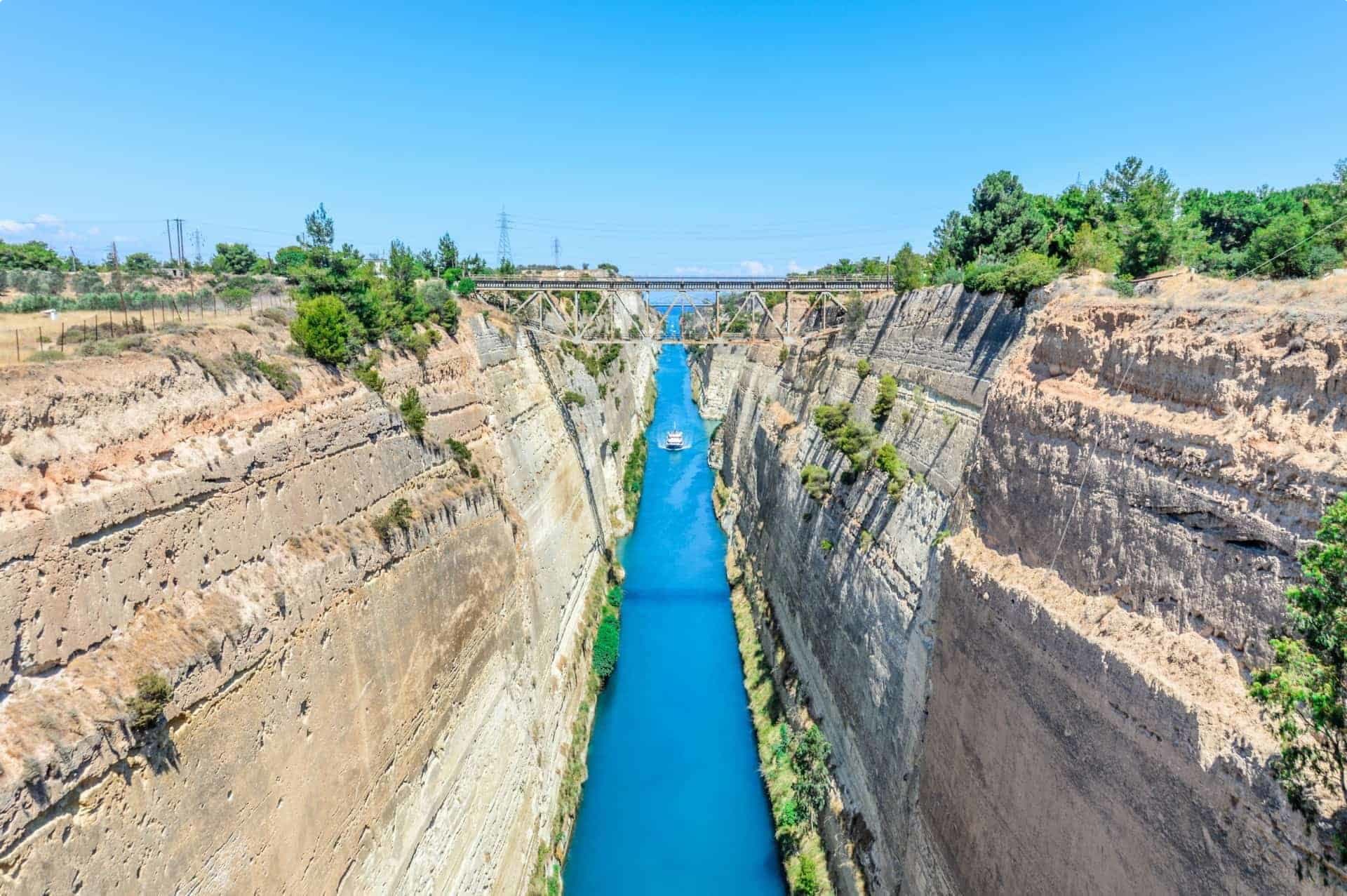
Modern-day Greece has a land area of 131,957 square kilometres and is located on the peninsula in the south-eastern corner of Europe. The extremely mountainous landmass is surrounded by the Aegean Sea to the east, the Mediterranean to the south and the Ionian Sea to the west. Greece shares land borders with Albania, the former Yugoslav Republic of Macedonia, Bulgaria and Turkey. Greek territory includes more than 2,000 islands, although only 166 are inhabited. Some of these islands are major holiday resorts. Most of the land is of sedimentary origin although there are significant intrusions of volcanic and plutonic formations. The coastline is very indented with many small bays and inlets. Earthquake activity is common in the region. Wherever possible the land is intensively cultivated and grazed.
Climate
Greece enjoys a typical Mediterranean-type climate characterised by hot summers and warm winters. Rainfall is concentrated in the winter months with dry summers. It is spring in April/May and early autumn in September/October. Temperatures are significantly warmer in the south and along the coasts and decrease to the north and inland. The following climatic statistics for the months of May and September may be of interest:
Location Max. Min. Rain Days Location Max. Min. Rain Days May September Athens 24°C 8°C 4 Athens 29°C 19°C 4 Corfu 23°C 14°C 6 Corfu 28°C 18°C 5 Mykonos 22°C 13°C 5 Mykonos 26°C 20°C 1 Rhodes 23°C 14°C 2 Rhodes 28°C 22°C 1 Crete 24°C 13°C 5 Crete 28°C 18°C 3Travel tips for Greece
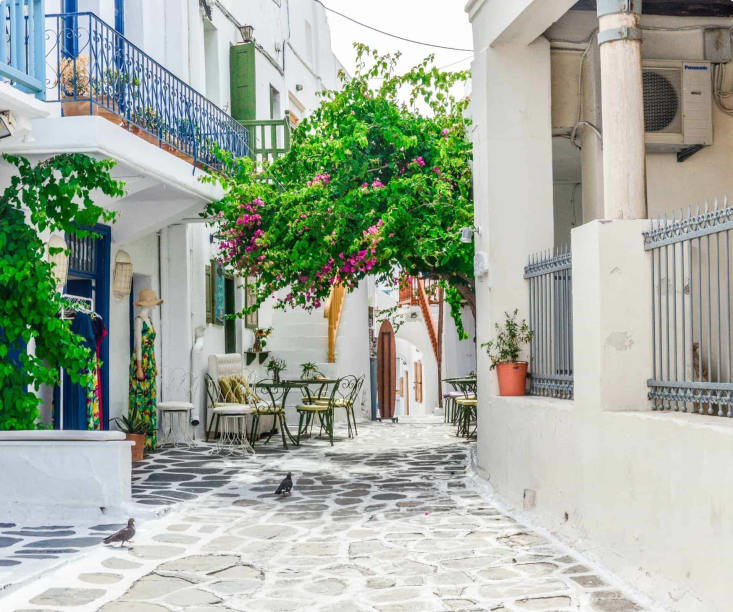
- The Greeks measure politeness by behaviour, not words. As such, you will notice an air of informality – everyone is treated like a cousin! In fact, over-emphasised spoken politeness may be interpreted as pretentiousness. So just go with the flow, and follow the lead of locals around you.
- Greeks like to use their hands to communicate. A lot. Why not get in on the act and have fun!
- On the subject of hand gestures, to “swear” at someone using their hands, Greeks put out their entire hand, palm open, five fingers extended out, like signalling someone to stop. This is called “mountza”. Sometimes they will do this by saying “na” (here) as well. It is basically telling someone to screw off or that they did something totally ridiculous. “Mountza” is known to come from a gesture used in the Byzantine era, where the guilty person was applied with ash on his/her face by the judge’s hand, in order to be ridiculed. Therefore, be careful when refusing something in Greece: when refusing the offer of drink, it’s best to put your palm over your glass (or any other refusing gesture that limits the showing of the palm).
- In Greece, it is proper etiquette for a stranger to make the first move. Bear this in mind when entering a cafe or passing a group on the street. You may feel you are being ignored, when in fact, if you take the initiative and say hello first, you will likely be met with friendliness and hospitality
- Note that Greeks take sport and politics very seriously.
- Dress codes for churches involve covered shoulders for women, and covered knees for both women and men. Though this may be relaxed in some cases, particularly in the warmer months, you might like to carry a sheer scarf to wrap around yourself. Alternatively, many major churches have appropriate clothing available at the door. Just wear it in, and drop it off on your departure.
- Avoid describing Greece as an Eastern European country. This is not geographically correct, and Greece prides itself on its pro-Western attitude compared with its Soviet neighbours
- Likewise, don’t describe it as Balkan country. It is correct to call Greece a Southern European country
- Macedonia is a sensitive issue. Also, tread carefully when discussing Ancient Greece and the Byzantine Empire. This history is a great source of pride and culture for the Greeks.
- It is strictly forbidden to take photos of military installations or other strategic locations. Authorities will take violations quite seriously. Obey signs prohibiting photography. In fact, it would be best not to take photographs of anything of military significance, including Greek navy ships, or of airports or any aircraft, even civilian ones
- Leisure is the number one priority in Greece. They work to live, not the other way around. So, rather than get frustrated, give in to the pace here. You’ll soon find the relaxation is contagious!
Tours to Greece for senior travellers
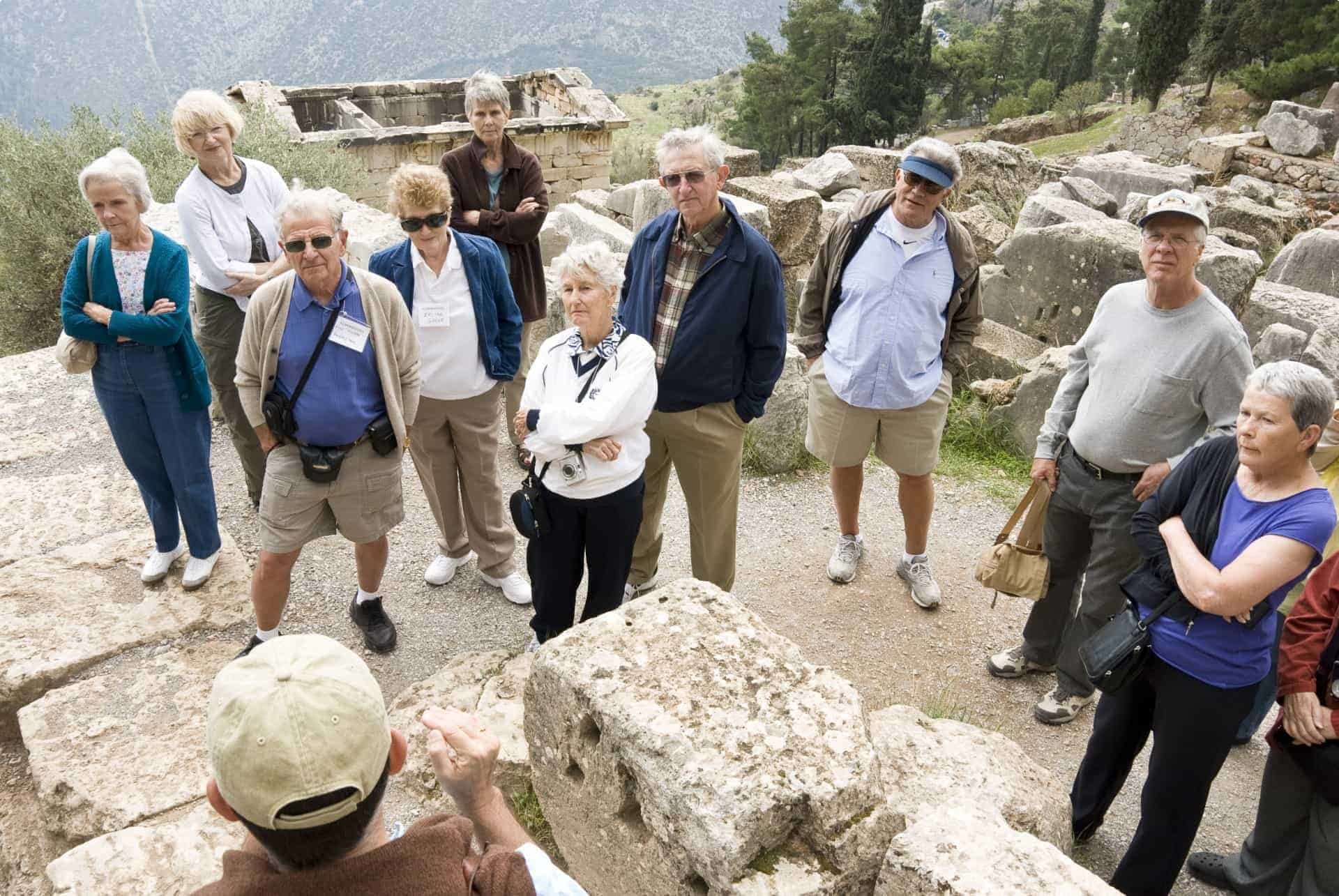
Our Greece small group escorted history tour explores this ancient land of great philosophers, myths and legends. We will learn about the culture and heritage of modern Greece, which finally became an independent nation in 1832, when it broke free from the Ottoman Turks who had ruled the land for centuries. We will experience the icons and heritage of Ancient Greece, from its mountainous interior to the rugged coastline of the Peloponnese and the Ionian, Cyclades and Dodecanese Islands, together with a day visit to the Turkish port of Kusadasi and a visit to Ephesus.
Its location has influenced not only its own history and culture but also that of the modern world. Indeed, many historians believe that ancient Greek philosophy forms the cornerstone of western culture. The word democracy (“government by the people”) derives from Ancient Greek. We will experience and learn about the way in which the Ancient Greek traders and city states influenced their world and reflect upon how modern Greece has influenced ours.
Alternatively, if you’d prefer to stay closer to home but still have a keen interest in Greek history, you might like to consider our summer schools program. We offer a week-long course called The Glory of Greece, which will cover Greek history from ancient times to the present. Our summer schools are delivered using a variety of different media. This particular course will include tutorial discussions, the examination of historic source material and cultural artefacts, “virtual visits” to key Greek sites, and cinematic interpretations of the Homeric epics. Our summer school takes place in picturesque Hobart, where we stay in full en suite accommodation. Places in our summer school are limited, and we recommend booking early to secure your spot. For more information, click here.
Odyssey Traveller’s small group tours
Odyssey Traveller is a not-for-profit organisation offering Australia and New Zealand’s most comprehensive educational tour programs. We provide worldwide experiences for mature travellers who are keen to blend a love of travel with a thirst for knowledge, and we welcome participants from any country.
Odyssey Traveller is famous for our small groups, and we average eight participants per tour. Our maximum group size is eighteen people, which ensures quality, flexibility and care that is tailored to our clients. We specialise in small group tours for the senior traveller who is seeking adventure or is curious about the world we live in. Typically, our clients begin travelling with us from their mid 50’s onward. But be prepared to meet fellow travellers in their 80s and beyond! Both couples and singles are welcome.
About Odyssey Traveller

Odyssey Traveller is committed to charitable activities that support the environment and cultural development of Australian and New Zealand communities. Accordingly, we are pleased to announce that since 2012, Odyssey has been awarding $10,000 Equity & Merit Cash Scholarships each year. We award scholarships on the basis of academic performance and demonstrated financial need. We award at least one scholarship per year. We’re supported through our educational travel programs, and your participation helps Odyssey achieve its goals.
For more information on Odyssey Traveller and our educational small group tours, visit our website. Alternatively, please call or send an email. We’d love to hear from you!
More travel advice and articles from Odyssey Travellers.
If you enjoyed this article on Greece from Odyssey Travellers then the following links to articles published by us may also be of interest.
- Travel advice for Solo travellers
- Discovering the Islands of Greece
- Avoiding queues on holidays
- Nifty gadgets and gizmos
Please do not hesitate to share these articles with friends and family if relevant.
Related Tours
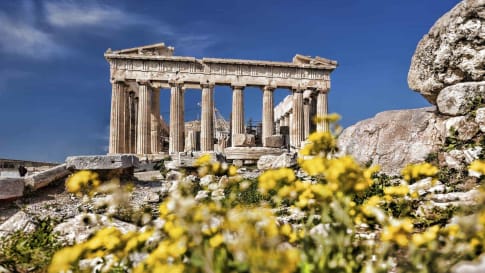
22 days
Apr, Sep, MayGreece small group escorted history tour
Visiting Greece
Our 22 day small group tour explores the land of great philosophers, myths, and legends. We will learn about the culture and heritage of modern Greece whilst exploring and learning Athens, which only found independence in its uprising from the Ottoman Empire in the 19th century.
From A$14,145 AUD
View Tour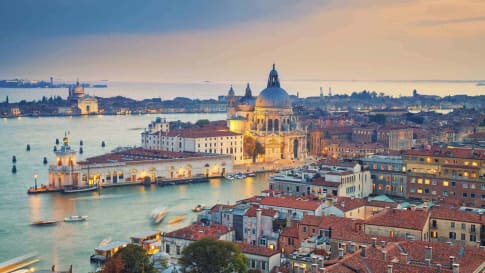
27 days
DecEuropean Cities Small Group History and Cultural Winter Tour
Visiting Albania, Croatia
An escorted tour A Journey that commences in Rome and takes in 12 destinations along its journey to Athens. This is an off season small group journey with like minded people. A small group tour across Southern Europe with local guides sharing authentic in-country authentic experiences for mature couples and solo travellers.
From A$17,295 AUD
View Tour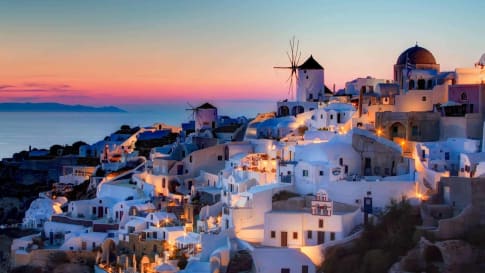
21 days
Apr, OctSantorini, Crete and Cyprus Small Group Tour | Eastern Mediterranean Islands Tour
Visiting Cyprus, Greece
A fascinating small group tour, with an amazing mix of culture and history – the islands of Greece, the cradle of Western civilisation, where traces of a centuries-old history exists. Visit Santorini, a remnant of a volcanic era; Crete, the home of the Minoan civilisation with important archaeological finds at Knossos and Phaistos. Rhodes, inhabited since the Stone Age; and venture further to the island of Cyprus, where east meets west.
From A$17,545 AUD
View Tour